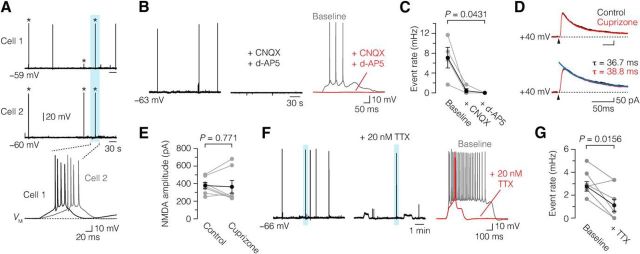Figure 8.
Glutamate-receptor and sodium channel dependence of demyelination-induced spontaneous up-state AP events. A, Top, Simultaneous baseline current-clamp recording from two chronic demyelinated L5 pyramidal neurons (Cell 1 and Cell 2) shows correlated up-state AP events, indicative of a network-driven mechanism. Bottom, Temporally correlated up-state AP events (blue area) on an expanded time, showing the multiple APs of such events. Asterisk (*) indicates synchronous events. B, C, Voltage traces of spontaneous up-state AP events in response to bath application of CNQX (20 μm) and d-AP5 (50 μm). Bath application of CNQX alone reduced the up-state AP event rate (baseline, 7.1 ± 2.1 mHz; with CNQX, 0.42 ± 0.42 mHz). Coapplication of CNQX and d-AP5 led to a complete block of the spontaneous events (0.0 mHz, n = 4 chronic neurons). Friedman followed by Dunn post hoc test. D, E, Top, Overlaid and aligned traces of basal NMDA currents, evoked by lateral stimulation in control condition (black) and during bath application of 100 μm cuprizone (red, n = 7 control neurons). Bottom, Same current traces on an expanded time scale fitted with double-exponential fit (blue lines). NMDA currents were recorded in the presence of 20 μm CNQX and 2 μm gabazine (SR 95531). Bath application of cuprizone did not affect the NMDA current amplitude or the decay time constant (τ). Black arrows indicate extracellular stimulus artifacts. F, G, 20 nm TTX significantly reduced the event rate of up-state AP events in demyelinated L5 neurons (baseline, 2.8 ± 0.4 mHz; with TTX, 1.1 ± 0.5 mHz, n = 2 acute and 6 chronic neurons). Paired Wilcoxon test. Data are presented as mean ± SEM.

